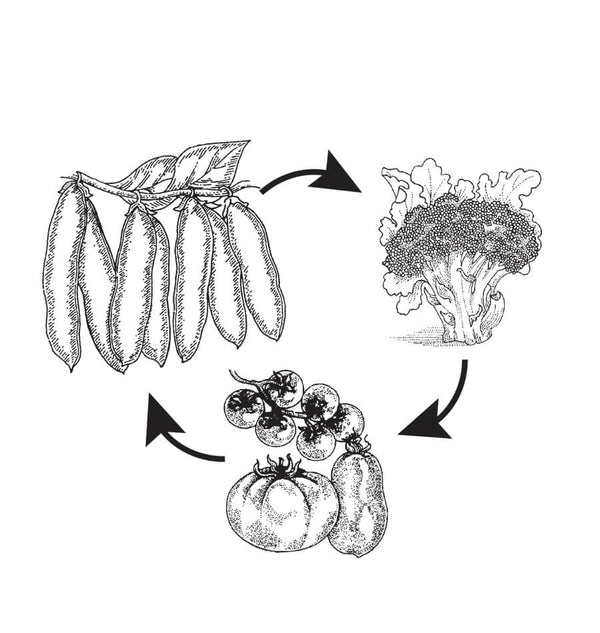Support Food Banks Canada with every dollar spent — 15% sales donated from Black Friday to Cyber Monday.
Time remaining:
Time remaining:

Crop rotation is the practice of not growing plants where similar plants grew the previous year. Crop rotation prevents the build up of pests and diseases and optimizes the use of soil nutrients. Plants from different “families” need different amounts of...
Continue ReadingAbout Compost and Composting Composting is the process of breaking down organic material. It is one of the basic principles of organic and biodynamic gardening, and has been in practice for a surprisingly long time. Pliny the Elder refers to...
Continue ReadingIn our relatively short growing season, we need to grow most food crops in a fairly intense way. We need to select crops that mature quickly. Some crops, like mescluns and salad greens grow so fast that we can take...
Continue ReadingWith over 1,100 seed varieties to choose from, finding a clear path to the checkout can feel overwhelming. There are beginner mistakes to be made - as well as ways for seasoned gardeners to bite off more than they can chew. Here are Mark's top ten pointers to consider when planting a new garden.
Continue ReadingDeciduous trees can't make enough of the short days and the sun appearing low on the horizon, so nearly all of them shed their leaves. The sugars in the drying leaves convert into starches and are drawn back into the tree trunk as the tree enters dormancy. This causes the dramatic change in leaf colours and leads to leaves falling.
Continue ReadingPlants need water – that’s a fact. And many vegetable crops need quite a lot of water (along with sunshine and nutrients) to produce the tasty roots and fruits that nourish us year round. Part of the goal of organic...
Continue ReadingThe arrival of third week in June brings us the last day of spring and the first day of summer. This year, it will occur at 2:43pm (PST on the west coast of North America, or 9:43pm GMT) on Saturday,...
Continue ReadingThe much maligned dandelion actually has a lot to offer. It has been vilified in our culture as the invader of lawn spaces, thrusting its dazzling yellow colour into an otherwise tranquil field of green. Homeowners pour millions of gallons...
Continue ReadingLawn is unsustainable. For all its demands of water and mowing energy, it gives very little in return. Space that could be used for growing food, or even simple wildflowers, is dedicated instead to endlessly demanding, non-native grass. On a suburban cul...
Continue ReadingThere’s nothing quite as perfect as a ripe tomato – that distinctive fresh, green smell of a sun-warmed fruit that bursts in the mouth. It speaks of the summer’s heat like nothing else in the garden — but it does require starting tomatoes indoors.
Continue ReadingCilantro and dill are both good examples of umbelliferous plants. When these plants bloom, the flower structure is in a shape called an umbel — scores of tiny flowers arranged on a more or less flat or umbrella-shaped plane. Other...
Continue ReadingWest Coast Seeds has conducted significant research into the companion planting guidelines and has defined the best possible results and reasons for each of our recommendations in our companion planting chart, below are a few thoughtful suggestions for you while planning your garden this year.
Continue ReadingThe Heat Mats are fairly thick, with several layers of plastic heat bonded (not glued) over a strong heating wire. Water can't get into the mat so there are no worries when irrigating plant trays. At the end of the seed starting season we just roll them up and store them for next year — and we've been using the same ones for more than five years.
Continue ReadingWhat the heck is xeriscaping? Simply put, xeriscaping is a system of landscaping with water conservation as the priority. In areas that receive little rainfall in the summer, some thoughtful xeriscaping will allow flowering plants to thrive, adding visual appeal...
Continue ReadingCSAs represent one of the ways that small organic farmers are changing the way we think about food, the way we access food, and how we, as consumers, participate with food production. CSA stands for Community-Supported Agriculture, and we’ve talked...
Continue ReadingIn nearly any gardening situation, we have the opportunity to mentor — and to be mentored. Growing food organically is a life-long learning curve. Newbie gardeners sometimes feel shy about asking questions, but this is the way to learn. Master...
Continue ReadingFood miles measure the literal distance in mileage between the producer and the consumer. They’re used to demonstrate the relative carbon footprints of conventionally farmed and imported groceries. This isn’t an effort to make consumers feel guilty. It’s about better...
Continue ReadingWest Coast Seeds is a proud supporter of the amazing organization, Growing Chefs. These “Chefs for Children’s Urban Agriculture” bring food into the urban classroom in the form of raw ingredients that are completely unfamiliar to the students. Their mission...
Continue ReadingIf you ever find yourself tempted to purchase kale from a supermarket, you really ought to try growing it. By its nature, kale is one of the easiest, hardiest, and most productive of all crops. It doesn’t need warm soil...
Continue ReadingAs we continue this Twenty-one Days of Green, planting trees seemed like an obvious choice. There are several fruit trees already growing on the farm at West Coast Seeds, so the idea came to expand the orchard area and expand...
Continue ReadingWith just eight more days left to Earth Day, we thought it would be good to list some of the many Earth Day events planned for next weekend. There are some big events in the city, and lots of local...
Continue ReadingOne of the amazing opportunities facing all gardeners and farmers is planting for wildlife — or, at least, growing food with biodiversity in mind. Organic gardeners understand that soil health is inherently dependent on robust biodiversity in the soil. Earthworms,...
Continue Reading